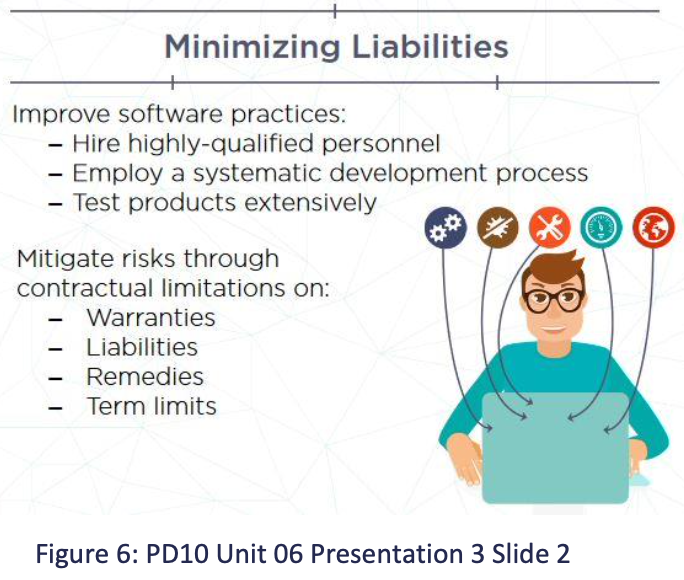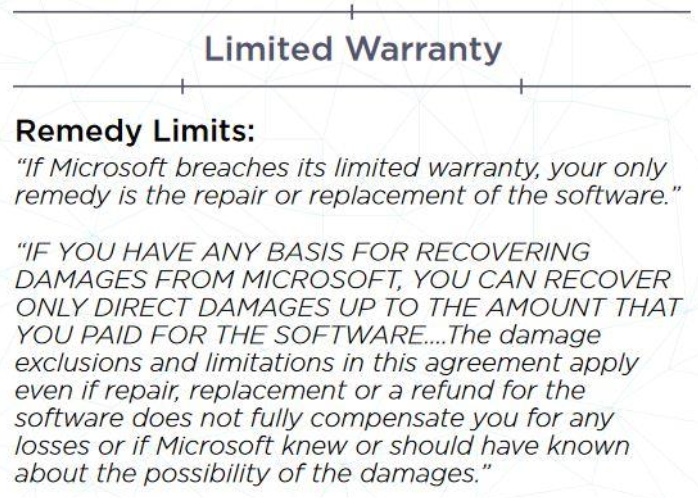Warranty
Warranty Disclaimers
At one extreme is total disavowal of any warranty or liability, as represented in the Figure 6. These are in the forms of disclaimers or express limitations, usually expressed prominently in clauses of a procurement contract or licence agreement. Such clauses are often in all capital letters because the law requires disclaimers and limitations on liability to be conspicuous.
In other words, they are to be displayed in such a manner that it is reasonable to expect the buyer or user to notice them and hopefully to read them!

Disclaimer of Warranty vs. Disclaimer of liability
Note that a disclaimer of warranty is different from a disclaimer of liability.
A warranty deals with promises about the quality of the software or its suitability for a particular purpose. A disclaimer says that the software producer makes no promises about the quality of the software.
Disclaimer of Liability
In contrast, a disclaimer of liability is a disavowal of any responsibility to compensate the users, or others, for damages incurred from the use of the software.
The disclaimer may try to be comprehensive and list all of the possible damages that a user might incur, disclaiming the software producer’s liability for any of them. Because software can play an integral part of a business (to the point that a software fault could cause the entire business to fail), you might see explicit disclaimers for consequential damages, like loss of income, loss of customers or goodwill, or the costs associated with a work stoppage.
However, there are some countries, provinces, or states that have local consumer-protection laws that take precedent over warranty disclaimers. In those cases, recognition by the courts of those disclaimers is not likely.
For example:
- When software is embedded in a consumer product, like a programmable thermostat or a smart television, it is unlikely that the software producer can legally disclaim warranties of merchantability and fitness for a particular purpose. More generally, a court may rule that a total disclaimer of liability is unconscionably one-sided, unfair, and surprising to the buyer.
Limited Warranty
Most commercial software will provide a limited warranty that makes some promises but tries to reduce the producer’s overall risk of liability by asserting limits on the extent of the warranty.
For example:

A limited warranty is also likely to impose a limit on remedies - that is, a limit on the amount that the software producer will compensate a user for losses.
For example:

In Microsoft’s limited warranty, in the event of a breach of warranty (that is, if the software does not perform substantially as described in its documentation), the only possible remedy is the repair or replacement of the software.
Further, if Microsoft is liable for any damages for any reason, the compensation for those damages caps at the amount that the user paid for the software. Thus, even if the user suffers extensive losses (such as the loss of data critical to the user’s business), the user is unlikely to recover any more than the price of the software.
Shifting / Sharing Liability With User
Another strategy to limit liability is to legally shift some responsibilities and liabilities to the user. The software or service contract will include clauses that obligate the user to use the software as intended. Examples of such clauses might include:
- Installing the software on suitable hardware
- Keeping the software up-to-date
- Applying all bug fixes
- Providing adequate training to users, or in some cases to insist that users meet certain qualifications (e.g. medical software may require that the users be medical professionals)
Failure to use the software as intended may absolve the software producer of their liabilities (or at least share liability with the user) if something goes wrong and the user suffers losses.
Limiting Software Functionality
Lastly, many software producers minimize their risks of liability by abstaining from services or features that could cause serious damage.
For example, in the medical domain, many software programs and devices provide diagnostics but don’t provide therapy. There are many programs that make recommendations but not actual decisions; the actual decision-making is left to the human user.
Note
Organizations that are willing to assume higher risks and to automate riskier functionality tend to be companies with deep pockets (such as automobile or aeronautical companies, or Google) or agencies that have government backing (such as defense contractors or the nuclear power industry). In other words, they are organizations that can afford huge liability claims, should their software causes serious damage.